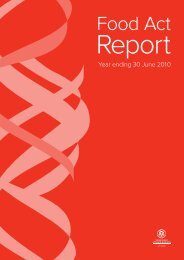Public Health Bulletin Edition 1, 2004 - SA Health - SA.Gov.au
Public Health Bulletin Edition 1, 2004 - SA Health - SA.Gov.au
Public Health Bulletin Edition 1, 2004 - SA Health - SA.Gov.au
You also want an ePaper? Increase the reach of your titles
YUMPU automatically turns print PDFs into web optimized ePapers that Google loves.
Reducing Cancer Risk Through<br />
Primary Prevention<br />
Cynthia Spurr<br />
Chief Project Officer, Department of <strong>Health</strong><br />
Michele Herriot<br />
Manager <strong>Health</strong> Promotion Programs,<br />
Department of <strong>Health</strong><br />
Over the past 40 years, research has identified primary<br />
prevention approaches that reduce the risk of people<br />
developing many types of cancer. The evidence outlining<br />
the relationship between risk factors and cancer outcome<br />
has been summarized by the National <strong>Health</strong> Priority<br />
Action Council in the draft National Service Improvement<br />
Framework for Cancer, 1 as follows:<br />
“Reduce smoking: Tobacco smoking c<strong>au</strong>ses the following<br />
cancers: lung; oral; nasal cavity and paranasal sinuses;<br />
naso-, oro- and hypopharynx; larynx; oesophagus;<br />
pancreas; stomach; liver; kidney; urinary tract; cervical;<br />
myeloid leukaemia, vulva, penis, bladder, renal parenchyma<br />
and renal pelvis 2-4 . In 2001, 19.5% of Australians (3.07<br />
million Australians) aged 14 years and older smoked daily.<br />
Limit alcohol intake: Alcohol is a c<strong>au</strong>sal factor for cancer<br />
of the mouth, pharynx, liver, larynx, oesophagus and<br />
breast cancer in women 2,3 . The Australian Institute of<br />
<strong>Health</strong> and Welfare (AIHW) has estimated that 12% of<br />
breast cancer may be attributable to alcohol intake. In<br />
2001, 9.9% of people consumed alcohol in a manner that<br />
put them at risk of long-term harm, while 34.4% put<br />
themselves at risk of short-term alcohol-related harm on<br />
at least one drinking occasion 5 .<br />
Increase protection of skin from the sun: Basal cell<br />
carcinoma, squamous cell carcinoma and melanoma are<br />
c<strong>au</strong>sed by sun exposure 6 . Sun protection will prevent<br />
approximately 90% of skin cancers. In 1999, between<br />
78-82% of Australian secondary students, aged 12-17<br />
years reported being sunburnt last summer.<br />
Improving diet mainly by increasing the intake of fruit<br />
and vegetables: The expert panel of the World Cancer<br />
Research Fund concluded that inappropriate diets c<strong>au</strong>se<br />
around one-third of all cancer deaths 7 . It recommended<br />
dietary diversity to maximise the likelihood of more<br />
balanced as well as more adequate diets, noting that<br />
there was convincing evidence of dietary protection<br />
against cancer of many sites. The evidence was strongest<br />
and most consistent for diets high in fruits and vegetables.<br />
In 1995 in Australia approximately 44% of males and<br />
34% of females did not consume fruit in the 24 hours<br />
preceding the National Nutrition Survey, and 20% of<br />
males and 17% of females did not consume vegetables 8 .<br />
27<br />
Reduction in rates of overweight and obesity: There<br />
is sufficient evidence for a cancer-preventive effect from<br />
avoidance of weight gain for cancer of the colon, breast<br />
(post-menop<strong>au</strong>sal), endometrium, kidney (renal-cell) and<br />
oesophagus (adenocarcinoma) 9 . For premenop<strong>au</strong>sal breast<br />
cancer, the available evidence suggests a lack of a cancerpreventive<br />
effect. In 2001, an estimated 2.4 million<br />
Australian adults were obese (16% of men and 17% of<br />
women aged 18 years and over). A further 4.9 million<br />
Australian adults were estimated to be overweight but<br />
not obese (42% of men and 25% of women) 10 .<br />
Increased physical activity: There is sufficient evidence<br />
for a cancer-preventive effect of physical activity for cancer<br />
of the colon and breast, limited evidence for a cancerpreventive<br />
effect for cancers of the endometrium and<br />
prostate, and for all other sites the evidence is inadequate 9 .<br />
In 2000, 57% of Australian adults, aged 18-75 years,<br />
were spending sufficient time (ie, at least 150 minutes<br />
of walking, moderate and/or vigorous activity per week)<br />
being physically active for health benefits 11 .<br />
Increased rates of safe sex: Prevention of Human<br />
Papilloma Virus (HPV) infection would prevent cervical<br />
cancer 12 . However, there is inconsistent evidence about<br />
whether condoms can reduce the risk of HPV infection 12 .<br />
Meta-analyses suggest that there is little benefit 13;14 .<br />
However, ongoing randomised trials suggest there may<br />
be some benefit 15 .”<br />
Prevention strategies to address the determinants of<br />
health<br />
It is evident from the above that for some cancers, there<br />
is considerable knowledge about their c<strong>au</strong>ses. Given this<br />
evidence, what preventive approaches should be adopted<br />
at the population level to reduce cancer risks The<br />
framework below recognises that the health of individuals<br />
and populations is determined by many factors (e.g.<br />
social, educational, economic, environmental, early years,<br />
genetic, psychosocial factors, health behaviours and the<br />
health system) that may act alone or in conjunction with<br />
each other. It identifies a range of factors that determine<br />
health outcomes and impact on cancer risk. In designing<br />
effective preventive strategies effort needs to be directed<br />
towards different population groups in a range of settings<br />
and incorporating findings from life course research. The<br />
Ottawa Charter for <strong>Health</strong> Promotion outlines a range of<br />
strategies for effective interventions (see box). Adoption<br />
of a comprehensive range of strategies is essential for<br />
successful outcomes.

















